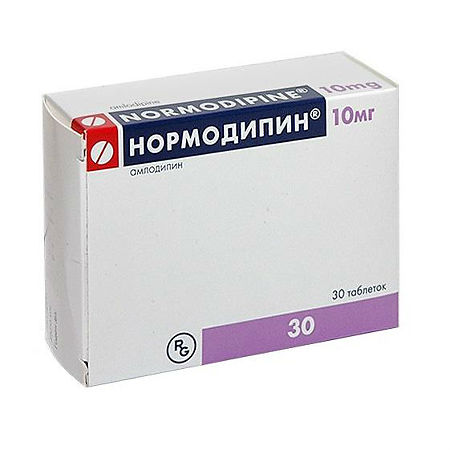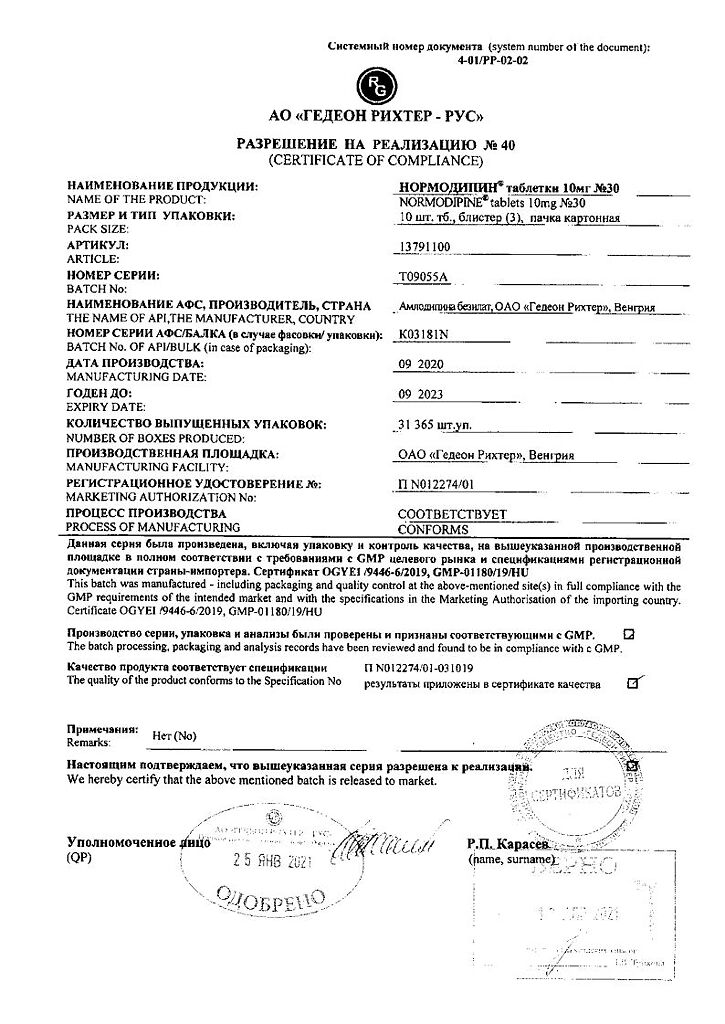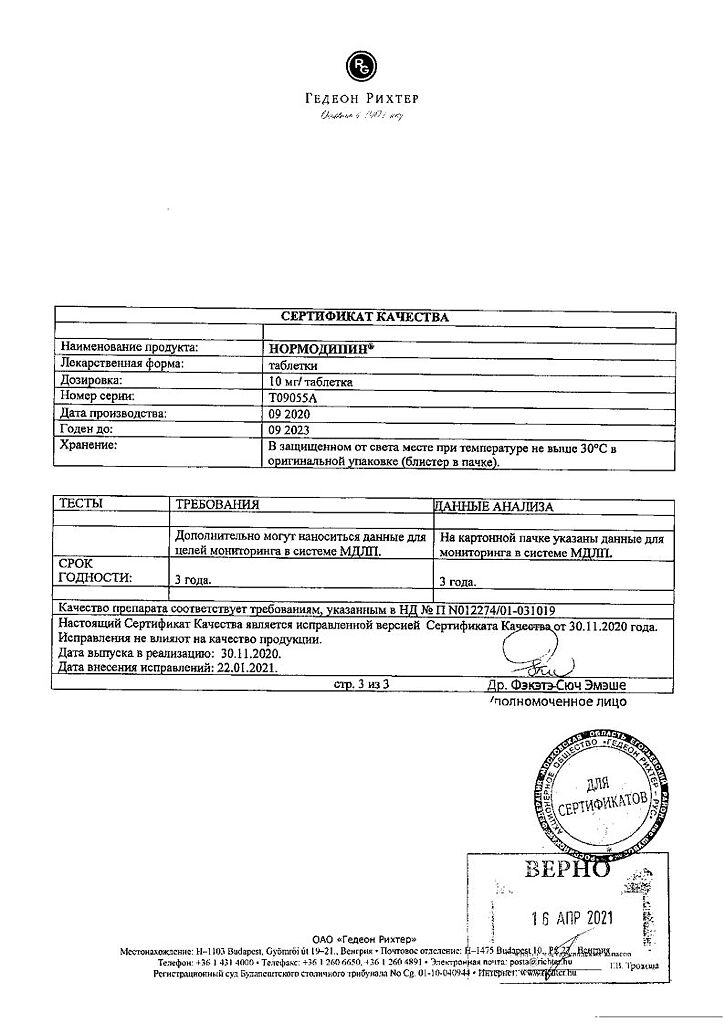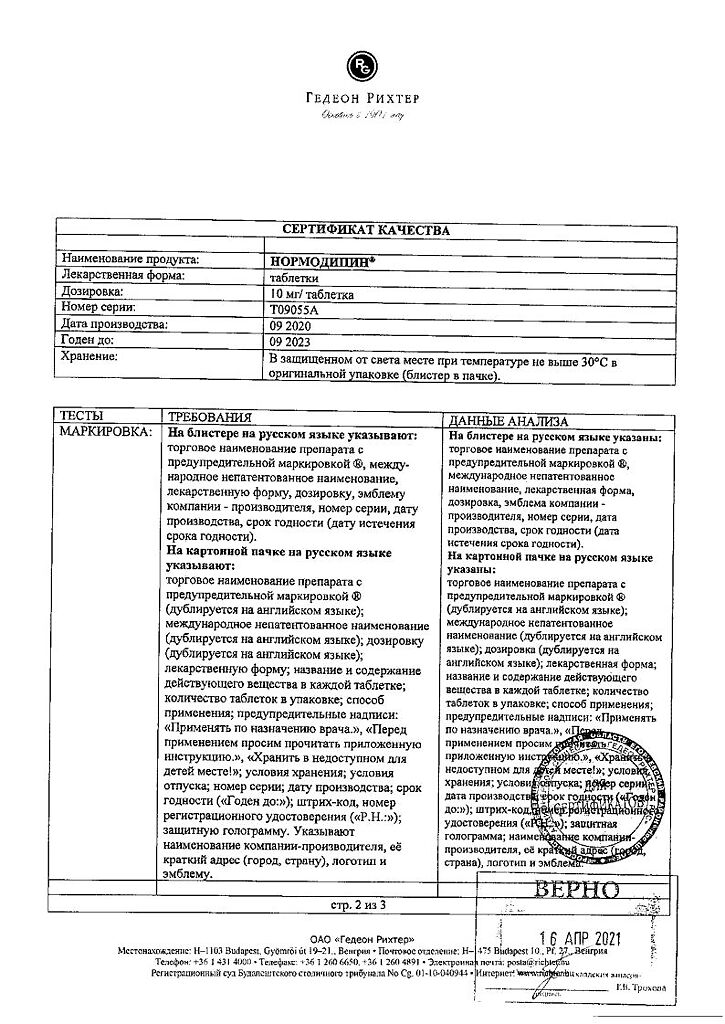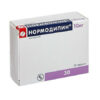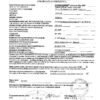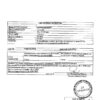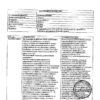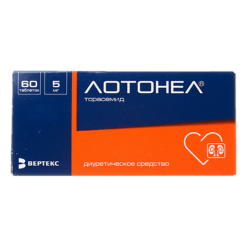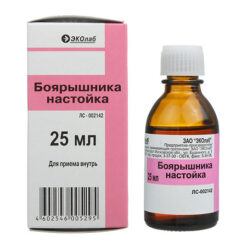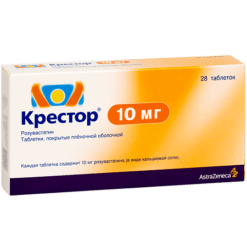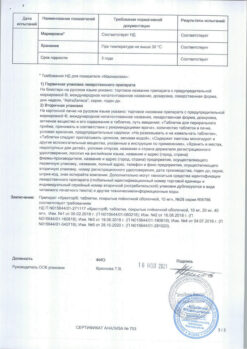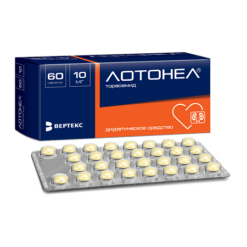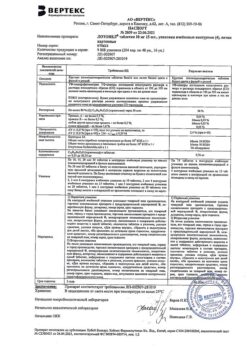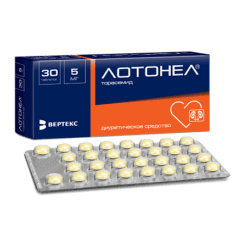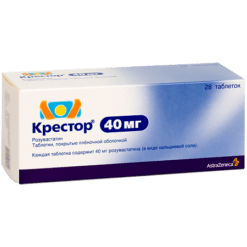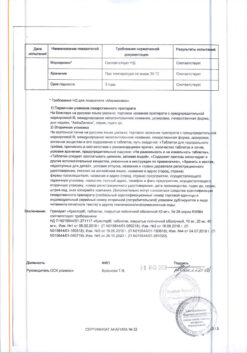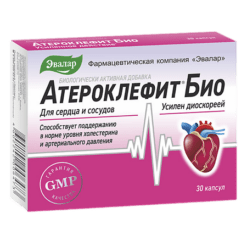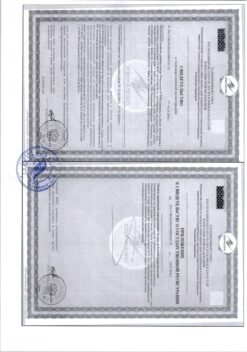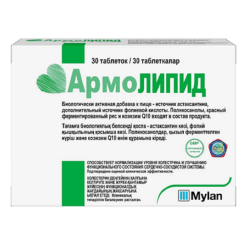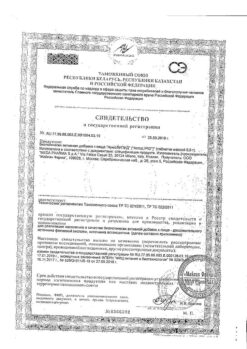No products in the cart.
Normodipine, tablets 10 mg 30 pcs
€6.15 €5.47
Description
Normodipine has antianginal, hypotensive effect.
A slow calcium channel blocker, a dihydropyridine derivative, has antianginal and hypotensive effects. Binding to segments S6 of III and IV domains of alpha1-subunit of L-type calcium channel, it blocks calcium channels, decreases transmembrane transition of calcium ions into cell (more in vascular smooth muscle cells than in cardiomyocytes).
Antianginal action is caused by the dilation of coronary and peripheral arteries and arterioles: in angina pectoris it reduces myocardial ischemia; dilation of peripheral arterioles reduces myocardial hypertension and decreases cardiac preload, reduces myocardial oxygen demand.
Dilates coronary arteries and arterioles in unchanged and ischemic areas of the myocardium, increases the flow of oxygen to the myocardium (especially in vasospastic angina); prevents the development of coronary artery spasm (including that caused by smoking). In patients with stable angina a single daily dose increases exercise tolerance, slows down the development of angina and “coronary” ST-segment depression, reduces the frequency of angina attacks and the use of nitroglycerin and other nitrates.
It has a long-term dose-dependent hypotensive effect. The hypotensive effect is due to a direct vasodilatory effect on the vascular smooth muscles. In arterial hypertension a single dose provides clinically significant reduction of BP during 24 hours (in “lying” and “standing” position of the patient).
Orthostatic hypotension when prescribing amlodipine is quite rare. It does not cause a decrease in exercise tolerance, left ventricular ejection fraction. It reduces the degree of left ventricular myocardial hypertrophy.
It does not influence myocardial contractility and conduction, does not cause reflex increase of heart rate, inhibits platelet aggregation, increases glomerular filtration rate, has weak natriuretic action. It does not increase the severity of microalbuminuria in diabetic nephropathy.
It has no adverse effect on metabolism and concentration of plasma lipids and can be used for treatment of patients with bronchial asthma, diabetes mellitus and gout.
The time of onset of effect is 2-4 hours, the duration of effect is 24 hours.
Pharmacokinetics
Intake
Intake slowly and almost completely absorbed from the gastrointestinal tract. Food intake has no effect on absorption. Cmax in plasma is reached after 6-9 h in both elderly and young patients. Average absolute bioavailability is 64%.
Distribution
The Css of amlodipine in plasma is reached after continuous use for 7-8 days.
The Vd is approximately 21 L/kg, indicating prevailing tissue distribution. It penetrates through the HEB and into the breast milk.
The binding to plasma proteins is 97%.
Metabolism
About 90% of amlodipine is biotransformed in the liver to form inactive metabolites.
Amlodipine is excreted from the body with urine (10% of dose – unchanged and 60% – as inactive metabolites) and in the feces (20-25% as metabolites). Excretion is biphasic, T1/2 is on average 31-48 hours. Total clearance of amlodiline is 7 ml/min/kg. Amlodipine is not eliminated by hemodialysis.
Pharmacokinetics in special clinical cases
The excretion of amlodipine is slower (T1/2 – 65 h) in elderly patients (older than 65 years) compared to younger patients, but these differences are not clinically relevant.
The prolonged T1/2 in patients with hepatic impairment suggests that long-term administration will result in higher cumulation of the drug in the body (T1/2 is up to 60 h).
The presence of renal impairment in a patient has no significant effect on the pharmacokinetics of amlodipine.
Indications
Indications
stable angina pectoris (as monotherapy or in combination with other antianginal drugs); arterial hypertension (as monotherapy or in combination with other antihypertensive drugs); vasospastic angina (Prinzmetal’s angina) (as monotherapy or in combination with other antianginal drugs).
Pharmacological effect
Pharmacological effect
Normodipine has an antianginal and hypotensive effect.
A slow calcium channel blocker, a dihydropyridine derivative, has antianginal and hypotensive effects. By binding to the S6 segments of the III and IV domains of the alpha1 subunit of the L-type calcium channel, it blocks calcium channels, reduces the transmembrane transition of calcium ions into the cell (more into vascular smooth muscle cells than into cardiomyocytes).
The antianginal effect is due to the expansion of the coronary and peripheral arteries and arterioles: in case of angina pectoris, it reduces the severity of myocardial ischemia; by expanding peripheral arterioles, it reduces peripheral vascular resistance, reduces preload on the heart, and reduces myocardial oxygen demand.
Expands coronary arteries and arterioles in unchanged and ischemic areas of the myocardium, increases the supply of oxygen to the myocardium (especially with vasospastic angina); prevents the development of spasm of the coronary arteries (including those caused by smoking). In patients with stable angina, a single daily dose increases exercise tolerance, slows down the development of angina and “ischemic” depression of the ST segment, reduces the frequency of angina attacks and the consumption of nitroglycerin and other nitrates.
It has a long-term dose-dependent hypotensive effect. The hypotensive effect is due to a direct vasodilating effect on vascular smooth muscle. For arterial hypertension, a single dose provides a clinically significant reduction in blood pressure over 24 hours (in the patient’s “lying” and “standing” position).
Orthostatic hypotension when prescribing amlodipine is quite rare. Does not cause a decrease in exercise tolerance or left ventricular ejection fraction. Reduces the degree of left ventricular myocardial hypertrophy.
It has no effect on myocardial contractility and conductivity, does not cause a reflex increase in heart rate, inhibits platelet aggregation, increases the glomerular filtration rate, and has a weak natriuretic effect. In diabetic nephropathy, it does not increase the severity of microalbuminuria.
It does not have any adverse effect on metabolism and plasma lipid concentrations and can be used in the treatment of patients with bronchial asthma, diabetes mellitus and gout.
The onset of the effect is 2-4 hours, the duration of the effect is 24 hours.
Pharmacokinetics
Suction
When taken orally, it is slowly and almost completely absorbed from the gastrointestinal tract. Eating does not affect absorption. Cmax in blood plasma is reached after 6-9 hours in both elderly and young patients. The average absolute bioavailability is 64%.
Distribution
Css of amlodipine in blood plasma is achieved after continuous use for 7-8 days.
Vd is approximately 21 l/kg, indicating predominant tissue distribution. Penetrates through the blood-brain barrier and into breast milk.
Plasma protein binding – 97%.
Metabolism
About 90% of amlodipine is biotransformed in the liver with the formation of inactive metabolites.
Removal
Amlodipine is excreted from the body in the urine (10% of the dose unchanged and 60% in the form of inactive metabolites) and in feces (20-25% in the form of metabolites). Elimination is biphasic, T1/2 averages 31-48 hours. The total clearance of amlodiline is 7 ml/min/kg. Hemodialysis does not remove amlodipine.
Pharmacokinetics in special clinical situations
In elderly patients (over 65 years of age), the elimination of amlodipine is slower (T1/2 – 65 hours) compared to young patients, but these differences are not clinically significant.
Prolongation of T1/2 in patients with liver failure suggests that with long-term administration, the accumulation of the drug in the body will be higher (T1/2 – up to 60 hours).
The presence of renal failure in the patient does not significantly affect the pharmacokinetics of amlodipine.
Special instructions
Special instructions
Influence on the ability to drive vehicles and operate machinery
There have been no reports of the effect of Normodipine® on driving or operating machinery.
However, some patients, mainly at the beginning of treatment, may experience drowsiness, dizziness and other side effects from the nervous system. If they occur, the patient must take special precautions when driving a car and working with complex mechanisms.
During treatment with Normodipin®, it is necessary to monitor body weight and sodium intake, and prescribing an appropriate diet is indicated. It is necessary to maintain dental hygiene and follow-up with a dentist (to prevent pain, bleeding and gum hyperplasia). Patients with low body weight, patients of short stature and patients with severe liver dysfunction may require a lower dose.
If liver function is impaired, T1/2 of the drug may also be prolonged. Therefore, Normodipin® should be prescribed to such patients with caution.
Despite the fact that discontinuation of the drug Normodipin® is not accompanied by the development of withdrawal syndrome, it is advisable to discontinue treatment by gradually reducing the dose of the drug. The effectiveness and safety of the drug in hypertensive crisis have not been established.
Active ingredient
Active ingredient
Amlodipine
Composition
Composition
Active ingredient:
amlodipine;
Excipients:
magnesium stearate;
sodium carboxymethyl starch;
calcium hydrogen phosphate anhydrous;
MCC
Pregnancy
Pregnancy
Contraindicated.
Contraindications
Contraindications
clinically significant aortic stenosis; collapse; cardiogenic shock; severe arterial hypotension (systolic blood pressure less than 90 mm Hg); unstable angina (with the exception of Prinzmetal’s angina); hypersensitivity to amlodipine and other dihydropyridine derivatives; pregnancy; lactation period; age under 18 years (due to lack of clinical experience in use).
Caution: the drug should be prescribed for chronic heart failure of non-ischemic etiology of functional class III-IV according to the NYHA classification, liver dysfunction, SSSS (severe bradycardia, tachycardia), arterial hypotension, elderly patients, mitral stenosis, hypertrophic obstructive cardiomyopathy, acute myocardial infarction (and within 1 month after it).
Side Effects
Side Effects
From the central and peripheral nervous system:
often – headache, dizziness, increased fatigue, drowsiness; uncommon – asthenia, general malaise, hypoesthesia, paresthesia, peripheral neuropathy, tremor, vertigo, fainting, insomnia, mood lability, unusual dreams, increased excitability, depression, anxiety; very rarely – apathy, ataxia, agitation, amnesia.
From the cardiovascular system:
often – palpitations, peripheral edema (swelling of the ankles and feet), flushes of blood to the skin of the face; infrequently – excessive decrease in blood pressure; very rarely – development or worsening of heart failure, rhythm disturbances (bradycardia, ventricular tachycardia, atrial fibrillation), myocardial infarction, chest pain, orthostatic hypotension, vasculitis.
From the digestive system:
often – nausea, abdominal pain; sometimes – vomiting, constipation or diarrhea, flatulence, dyspepsia, anorexia, dry mouth, thirst; rarely – gum hyperplasia, increased appetite; very rarely – pancreatitis, gastritis, jaundice (due to cholestasis), hyperbilirubinemia, increased activity of liver transaminases, hepatitis.
From the hematopoietic organs:
very rarely – thrombocytopenic purpura, leukopenia, thrombocytopenia.
From the musculoskeletal system:
sometimes – muscle cramps, myalgia (with long-term use), arthralgia, back pain, arthrosis; rarely – myasthenia.
From the genitourinary system:
rarely – frequent urination, painful urination, nocturia, impotence; very rarely – dysuria, polyuria.
From the skin:
rarely – dermatitis; very rarely – purpura, xeroderma, skin pigmentation disorder.
From the senses:
rarely – visual impairment, diplopia, conjunctivitis, eye pain, xerophthalmia, tinnitus.
Allergic reactions: uncommon – skin itching, rash (including erythematous, maculopapular rash); very rarely – urticaria, angioedema, erythema multiforme.
Other: rarely – alopecia, gynecomastia, hyperuricemia, weight gain/loss, dyspnea, nosebleeds, increased sweating; very rarely – cold sticky sweat, cough, rhinitis, parosmia, impaired taste, impaired accommodation, hyperglycemia.
Interaction
Interaction
Amlodipine can be used simultaneously with NSAIDs (especially indomethacin), antibacterial agents and oral hypoglycemic agents. It is possible to enhance the antianginal and hypotensive effect of slow calcium channel blockers of the dihydropyridine series when used together with thiazide and loop diuretics, verapamil, ACE inhibitors, beta-blockers and nitrates, as well as enhance their hypotensive effect when used together with alpha1-blockers, antipsychotics.
Amlodipine can be safely used for the treatment of hypertension together with thiazide diuretics, alpha-blockers, beta-blockers or ACE inhibitors.
In patients with stable angina, the drug can be combined with other antianginal agents, for example, long-acting nitrates, beta-blockers or short-acting nitrates. Although negative inotropic effects have not generally been observed in amlodipine studies, some calcium channel blockers may potentiate the negative inotropic effects of antiarrhythmic drugs known to prolong the QT interval (eg, amiodarone and quinidine).
A single dose of sildenafil in a dose of 100 mg in patients with essential hypertension does not affect the pharmacokinetic parameters of amlodipine. Repeated use of amlodipine at a dose of 10 mg and atorvastatin at a dose of 80 mg is not accompanied by significant changes in the pharmacokinetics of atorvastatin.
Amlodipine with single and repeated use in a dose of 10 mg does not affect the pharmacokinetics of ethanol (drinks containing alcohol). Antiviral agents (ritonavir) increase plasma concentrations of slow calcium channel blockers, incl. amlodipine. Neuroleptics and isoflurane enhance the hypotensive effect of dihydropyridine derivatives. Calcium supplements may reduce the effect of slow calcium channel blockers.
When amlodipine is used together with lithium preparations, it is possible to increase the manifestation of neurotoxicity (nausea, vomiting, diarrhea, ataxia, tremor, tinnitus). Amlodipine does not change the pharmacokinetics of cyclosporine. Does not affect the serum concentration of digoxin and its renal clearance.
Does not have a significant effect on the effect of warfarin (prothrombin time). Cimetidine does not affect the pharmacokinetics of amlodipine. In in vitro studies, amlodipine does not affect the binding of digoxin, phenytoin, warfarin and indomethacin to blood proteins. A simultaneous single dose of 240 mg of grapefruit juice and 10 mg of amlodipine orally is not accompanied by a significant change in the pharmacokinetics of amlodipine.
Overdose
Overdose
Symptoms: tachycardia, marked decrease in blood pressure, excessive peripheral vasodilation (risk of developing severe and persistent arterial hypotension, including with the development of shock and death).
Treatment: maintaining the function of the cardiovascular system, elevation, gastric lavage, administration of activated charcoal, monitoring indicators of heart and lung function, above the level of the head, position of the lower extremities, monitoring blood volume and diuresis.
To restore vascular tone, use vasoconstrictors (in the absence of contraindications to their use); in order to eliminate the consequences of blockade of calcium channels – intravenous administration of calcium gluconate as hemodialysis is ineffective.
Storage conditions
Storage conditions
At a temperature not exceeding 30 °C
Shelf life
Shelf life
3 years
Manufacturer
Manufacturer
Gedeon Richter, Hungary
Additional information
| Shelf life | 3 years |
|---|---|
| Conditions of storage | At a temperature not exceeding 30 °C |
| Manufacturer | Gedeon Richter, Hungary |
| Medication form | pills |
| Brand | Gedeon Richter |
Related products
Buy Normodipine, tablets 10 mg 30 pcs with delivery to USA, UK, Europe and over 120 other countries.

